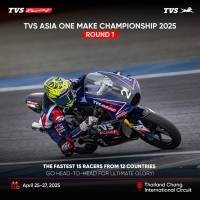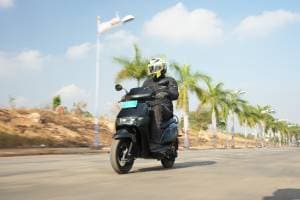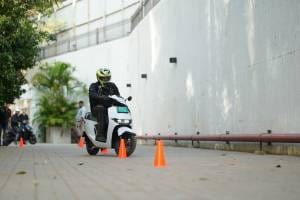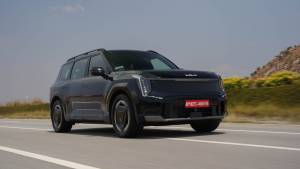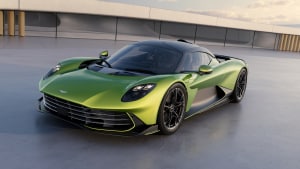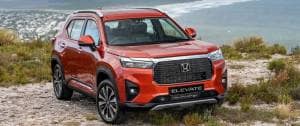Lessons learnt at the TVS Racing academy...
We've all raced at some point in our life, haven't we? I used to race my toy cars with my buddies when I was a kid. We then began racing on our bicycles, and occasionally at a karting track when we'd collect enough pocket money for a six laps around the circuit. Those days remain among the fondest memories of my life. I love racing, and I'm sure you do to.
Fast forward to May 29, 2017, and I was at the Madras Motor Race Track (MMRT) in Chennai riding a TVS Apache RTR 200 4V race bike! Dreams do come true, and this one was made possible, courtesy of the good folks at TVS Racing.
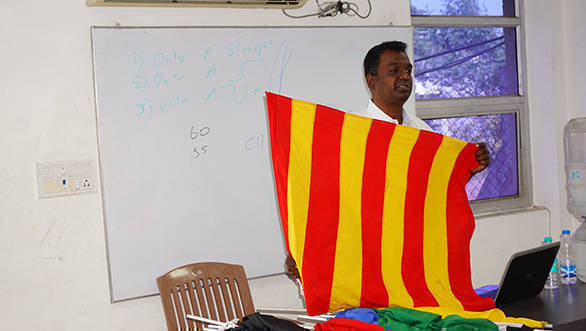 Emmanuel Jebaraj gives us a lesson in the various flags that are used to communicate with a rider on a race track. This one indicates slippery conditions
Emmanuel Jebaraj gives us a lesson in the various flags that are used to communicate with a rider on a race track. This one indicates slippery conditions
The racing division of the TVS Motor Company has participated in a number of racing championships in India, for decades and has also won a multiple national championships over the years.
This year, TVS Racing has decided to give us auto journos a chance to race in a one-make series championship. There'll be three race weekends in all, with the first one scheduled for June 9-10, 2017.
Yeah, well that's exciting, I thought to myself, but am I race ready? Does TVS think I, or any auto journo, is race ready? The answer to that is an emphatic no!
You see, our job allows us to ride almost every motorcycle in the country, big or small. But that does not qualify us as racing riders. That's because racing a different ball game altogether. Understanding racecraft is important to ride fast and safe around a racetrack, and it's something that can only be learnt at a racing school.
TVS organised a training school for journos, albeit for a day, and roped in the best in the business to ensure we learnt, at least, the basics of the art of racing.
The crew
It's always said that racers are a different breed. It's as if their DNA is infused with some sort of magic which gives them the ability to ride the way they ride. It's visible in the way they speak, walk, talk and ride. I think the one word that describes them is focus. They always are, in whatever task they undertake.
Which is probably why the chief instructor at the school was Emmanuel Jebaraj, an accomplished national-level champion. He has been racing since 1997 and his collective experience was evident in the knowledge he dispensed during the theory/ classroom sessions.
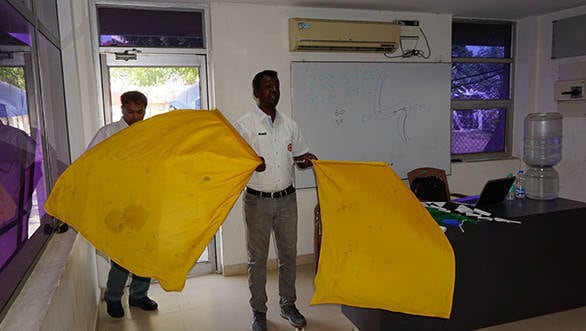
He was joined by TVS Racing's team riders Harry Sylvester, Jagan Kumar and KY Ahmed. The riders were the ones that joined us on the track, showing us how it's done after which they followed us around to see if we picked up what's being taught.
The lessons
Body position
The way you sit on a bike has a profound impact on what the bike does. Sitting incorrectly vastly affects your ability to ride a bike at its full potential. Emmanuel repeatedly stressed the importance of holding the bike with the lower part of the body, whilst keeping the upper body loose, ready to flow with the bike as it makes its way around a corner.
Later on, Harry got onto the Apache and showed us the correct way to place our feet on the pegs, which is always on the ball of the foot. He then taught us the right way to hold the bike, which is by using the inner thighs to hold the tank. Lastly, he showed us the right way to crouch into an aerodynamic position in order to attain the maximum possible speed down a straight.
Track familiarisation
You've seen racers at full clip around a racetrack. But think about this, do they get up speed from the word go? Is their first time on the track their quickest? No, not at all.
Racers study the circuit, in minute detail, every time they are out on the track. And by the circuit, it does not mean the piece of tarmac that they are riding on. They notice kerbs, trees, marshal posts, tyre walls, tyre marks, cones, trees etc. around the racetrack. This process is called track familiarisation and we were told to do so to understand the track as well as pick up reference points on the track.
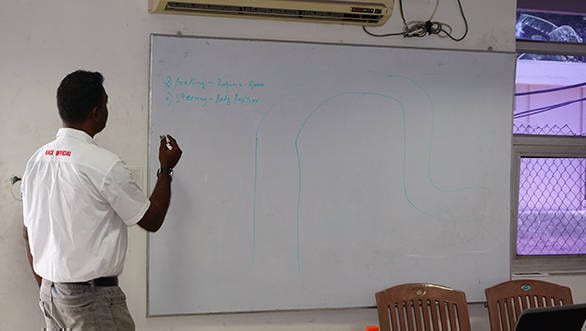
Racers always pick up reference points to give them an idea about their position on the track and the points at which they need to brake or turn. It certainly helps when you are riding at a pretty fast clip, especially when you are engaged in a battle with a fellow racer.
Throttle control
It's by far the most effective tool to ensure you are quick around a racetrack. A tool that'll help you in the battle against the clock, and set faster lap times. Jebaraj, during the classroom sessions, taught us the importance of the throttle control and the direct effect that it has on the bike's stability which, in turn, determines smoothness on the bike. And that is the key to fast lap times.
On the track, I could notice how even the slightest throttle input had an effect on the way the Apache behaved, whether mid-corner or on the straights. In corners where I was all ragged, especially when powering out of C3, I was able to able to power out smoothly with the bike following the line that I wanted. The bike also felt a lot more stable which, in turn, gave me confidence to go faster!
Braking points and turning points
Remember the reference points I was talking about. Those were very handy when I had to choose a point to brake before a corner. The braking point, we were told, is always before the turning point, because once turned in, you can't brake as that would disturb the bike's stability. The trick is to fix a marker on the circuit, usually the distance to corner boards, always placed the form of a countdown - 150m...100m..50m. Once you feel you've slowed down enough, you need to counter steer by pushing gently on the inside bar to tip the bike into the corner at the turning point. Once that's done, you need to roll on the throttle and power out of the corner.
It's a step by step process and it gave me quite a high when I managed to get it right with each passing lap.
Body position before corners, and the importance of lining the elbow and head
The second aspect of body positioning is to prepare to turn the bike into a corner. You must have seen a number of racers move one butt cheek off the seat with the inside leg stretched out before the corner. That's the ideal position before corner entry. The balls of the foot on the peg also help in this respect as it helps in locking the foot on the peg and preventing the toe box of the boot from scraping the tarmac.
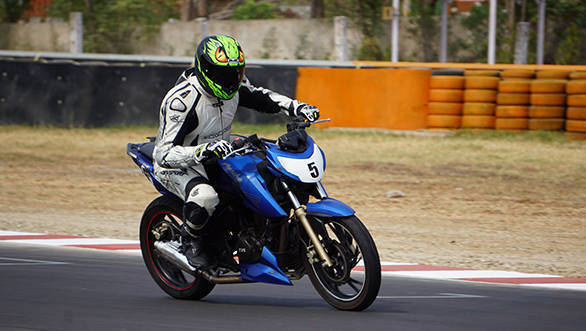 Trying hard to get my body position right. It is easier said than done
Trying hard to get my body position right. It is easier said than done
Besides hanging the lower body off the bike, the rider also needs to point his inner elbow in the direction of the corner while looking at the exit of the corner. When done right, the head, elbow and knee will be aligned in one line.
Leaning off the bike also ensures the bike is as upright as possible around a corner, which is crucial to ensure maximum tyre contact patch which has a direct bearing on available traction, and hence corner speed.
Head, vision and their effect on steering the bike in the intended direction
It's the golden rule when it comes to riding a bike - you always end up going where you look. This is one aspect of riding a motorcycle that can truly transform the way you ride. We were told how crucial it is to point your head and look at the direction where you want to go, and the bike would always follow that direction. On the track, this helped my riding to quite an extent.
During the first session, for instance, I almost ran off-track at entry of Turn 3 because I wasn't looking far enough into the corner.
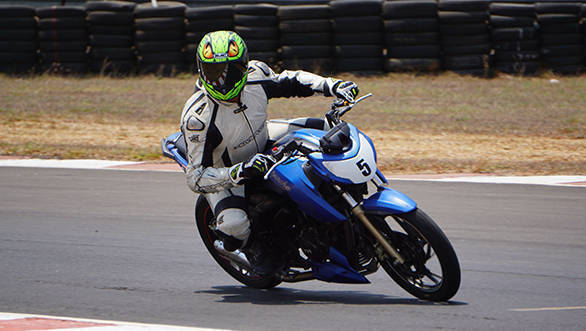 Lap times begin to tumble with each session as I practised what was taught in the classroom
Lap times begin to tumble with each session as I practised what was taught in the classroom
The remedy to that problem was that I had to keep my head up and look far ahead into Turn 4, as soon as I had turned into Turn 3, and it worked!
With each passing lap, I could enter and exit Turn 3 faster by pointing my head in the direction where I want to go. The lap times kept tumbling quickly as I could carry greater corner speeds, which explains how I managed to shave 12 seconds off my best lap time from the first session.
Braking limits
You've seen Valentino Rossi and Marc Marquez during the Moto GP races, and it's simply astonishing to see them brake so late and deep into the corner. Outbraking a competitor on the track is one of the sure-shot ways to overtake, but it also boils down to skill and guts. When I quizzed Jebaraj about how late one can brake without blowing it up, he only said, "You'll understand that during the race."
What I could only infer from that sentence is that my braking will be relative to my competitors. Ok then.
Crash management
"You have to remove fear out of your system, if you want to race. Crashing is a part of racing." Those words did get me a bit worried, but crashing is part of motorcycle racing, and I understand that the safety gear is designed to mitigate injuries. That said, there is a way to manage a crash that will ensure you are not hurt too bad.
The first and foremost thing to do is to keep your eyes open once you've fallen. The brain needs information to take the next step, which could be trying to avoid hitting something on track or another competitor. Keeping your eyes open will help your brain understand the situation.
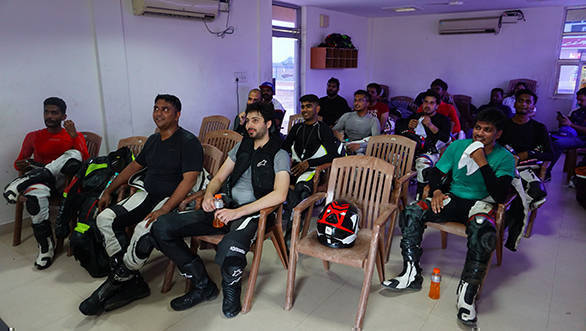
It is also vital to keep your head up as high as possible to reduce chances or severe injuries to one of the most delicate parts of the body. Case in point is the riders that fall off during races. You'll always find them keeping their head up when they are sliding across the track.
The hands also need to be kept crossed and against the chest to prevent them from hitting objects which could result in broken bones or dislocation. In case you are rolling, it's best to assume the shape of a ball to minimise injuries, we were told.
Fitness
This sport is extremely demanding and needs riders to maintain good health and fitness to last a race weekend. The school, in a way, was an eye-opener for me, someone who's always up for junk food and doesn't remember the last time he jogged. By the end of the last session I was drained and the muscles in my legs hurt. A fit body will also be able to handle crash impacts, far better than an unfit body.
Riding a bike on the track also requires one to be flexible, and this along with my fitness is what I need to work on for the three race weekends that follow this training programme.
In the end
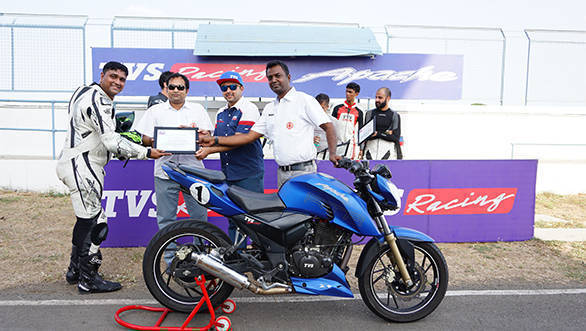
The school gave me an opportunity to understand the hard work and dedication that go into developing a motorcycle racer. It introduced me to the challenges that racers face and the way to overcome them. Although the school only taught us the basics of racing, it was enough to create a strong foundation. Of course, there are many more levels to cover before I get any closer to the blistering lap times that the TVS racers set. But, for now, the school has prepared me for the three of the biggest weekends of my life, beginning on June 9-10, 2017, at the Kari Motor Speedway in Coimbatore.
Images by TVS Racing
